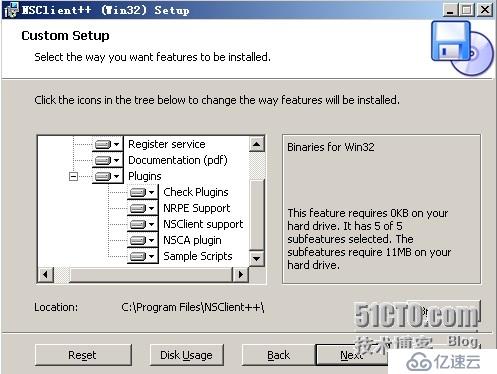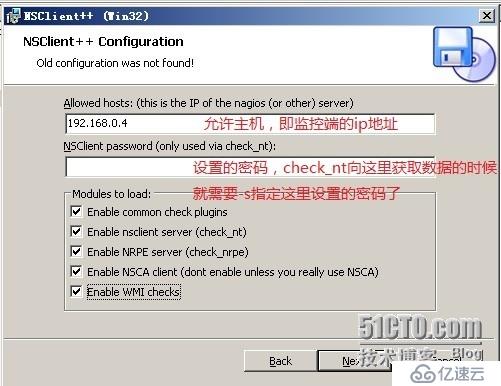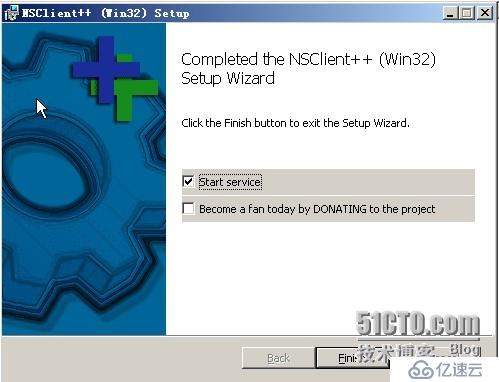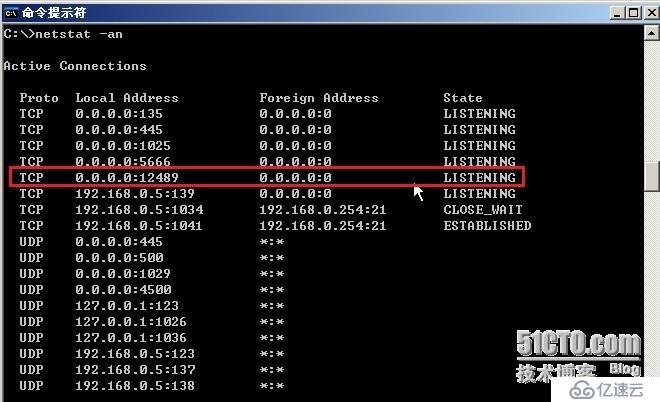NSClinet++监控Windows主机的nagios插件
下载地址:https://nsclient.org/nscp/downloads
下载NSClient++-xxx-Win32
我们这里下载的是NSClient++-0.3.9-Win32.msi
安装NSClient++
双击程序安装,前面都点下一步,从下面可以看出来NSClient集成了很多的插件NRPE、NSCA等都支持

添加允许主机

下面没什么需要注意的了,直接下一步,安装完成就可以了。

服务开启以后可以看到服务端的端口开启了,NSClient++使用的是12489端口,而且我们也看到nrpe的端口也开启了

1、基于check_nt
Windows端安装目录下NSC.ini配置文件的要启用的模块:
[modules]
CheckSystem.dll
CheckDisk.dll
FileLogger.dll
NSClientListener.dll
[settings]
allowed_hosts = #允许的主机
Password= #密码
修改配置后要重启服务:
nsclient++ /stop
nsclient++ /start
在nagios端使用如下命令测试:
check_nt -H <client ip> -p <port> -s <PASSWORD> -v <command> ...
# check_nt -H 172.16.100.66 -p 12489 -v CPULOAD -w 80 -c 90 -l5,80,90-s redhat
[root@node4 ~]# cd/usr/local/nagios/libexec/
[root@node4 libexec]#./check_nt -H 192.168.0.5 -p 12489 -v CPULOAD -w 80 -c 90 -l 5,80,90 -s redhat
CPU Load 0% (5 minaverage) | '5 min avgLoad'=0%;80;90;0;100
nagios端配置:
首先是命令配置:
[root@node4 ~]# cd/usr/local/nagios/etc/objects/
[root@node4 objects]#vim commands.cfg
define command{
command_name check_nt
command_line $USER1$/check_nt -H $HOSTADDRESS$ -p 12489-s redhat -v $ARG1$ $ARG2$
}
然后是主机配置:
# vim/usr/local/nagios/etc/objects/windows.cfg
define host{
use windows-server ; Inherit default values from a template
host_name winserver ; The name we're giving to this host
alias My Windows Server ; A longer name associated with the host
address 192.168.0.5 ; IP address of the host
}
###############################################################################
###############################################################################
#
# HOST GROUPDEFINITIONS
#
###############################################################################
###############################################################################
# Define a hostgroupfor Windows machines
# All hosts that usethe windows-server template will automatically be a member of this group
define hostgroup{
hostgroup_name windows-servers ; The name of the hostgroup
alias Windows Servers ; Long name of thegroup
}
###############################################################################
###############################################################################
#
# SERVICE DEFINITIONS
#
###############################################################################
###############################################################################
# Create a servicefor monitoring the version of NSCLient++ that is installed
# Change thehost_name to match the name of the host you defined above
define service{
use generic-service
host_name winserver
service_description NSClient++ Version
check_command check_nt!CLIENTVERSION
}
# Create a servicefor monitoring the uptime of the server
# Change thehost_name to match the name of the host you defined above
define service{
use generic-service
host_name winserver
service_description Uptime
check_command check_nt!UPTIME
}
# Create a servicefor monitoring CPU load
# Change thehost_name to match the name of the host you defined above
define service{
use generic-service
host_name winserver
service_description CPU Load
check_command check_nt!CPULOAD!-l 5,80,90
}
# Create a servicefor monitoring memory usage
# Change thehost_name to match the name of the host you defined above
define service{
use generic-service
host_name winserver
service_description Memory Usage
check_command check_nt!MEMUSE!-w 80 -c 90
}
# Create a servicefor monitoring C:\ disk usage
# Change thehost_name to match the name of the host you defined above
define service{
use generic-service
host_name winserver
service_description C:\ Drive Space
check_command check_nt!USEDDISKSPACE!-l c -w 80 -c90
}
# Create a servicefor monitoring the W3SVC service
# Change thehost_name to match the name of the host you defined above
define service{
use generic-service
host_name winserver
service_description W3SVC
check_command check_nt!SERVICESTATE!-d SHOWALL -lW3SVC
}
# Create a servicefor monitoring the Explorer.exe process
# Change thehost_name to match the name of the host you defined above
define service{
use generic-service
host_name winserver
service_description Explorer
check_command check_nt!PROCSTATE!-d SHOWALL -lExplorer.exe
}
在nagios配置文件内添加一条cfg
[root@node4 objects]# vim/usr/local/nagios/etc/nagios.cfg
cfg_file=/usr/local/nagios/etc/objects/windows.cfg
做完上述的操作以后重启nagios服务端的nagios服务
[root@node4 objects]#service nagios restart
Running configurationcheck...done.
Stopping nagios: done.
Starting nagios: done.然后在nagios的web管理界面上你就会发现一个新的主机

而且服务里面也多出很多我们定义的服务

密码保护:
如果你在windows的机器上设置了密码,你需要在commands.cfg配置文档内加上-s PASSWORD如下:
vi/usr/local/nagios/etc/objects/commands.cfg
define command{
command_name check_nt
command_line $USER1$/check_nt-H $HOSTADDRESS$ -p 12489 -s PASSWORD -v $ARG1$$ARG2$
}
Save the file.
2、基于NRPE
Windows上NSClient++要启用如下模块:
[modules]
CheckSystem.dll
CheckDisk.dll
CheckExternalScripts.dll
FileLogger.dll
NRPEListener.dll
NRPE specific settingin NSClient++
use_ssl #使用ssl
allow_arguments #是否允许nagios服务端传递参数过来
allow_nasty_meta_chars # 传递参数的时候是否可以包含一些&<>等字符
bind_to_address= #绑定在那个地址上,默认监听在0.0.0.0
allowed_hosts= #允许主机
check_nrpe语法:
check_nrpe ... -c<command> [-a <argument> <argument> <argument>]
check_nrpe的内置命令:
·CheckAlwaysCRITICAL (check)
·CheckAlwaysOK (check)
·CheckAlwaysWARNING (check)
· CheckCPU(check)
·CheckCRITICAL (check)
·CheckCounter (check)
·CheckEventLog/CheckEventLog (check)
·CheckFile (check)
·CheckFileSize (check)
· CheckMem(check)
·CheckMultiple (check)
· CheckOK(check)
·CheckProcState (check)
·CheckServiceState (check)
·CheckTaskSched/CheckTaskSched (check)
·CheckUpTime (check)
·CheckVersion (check)
·CheckWARNING (check)
·CheckWMI/CheckWMI (check)
·CheckWMIValue (check)
用法如:
# check_nrpe ... -cCheckCPU -a warn=80 crit=90 time=20m time=10s time=4
Nagios端的配置:
1) Template
define host{
nametpl-windows-servers
usegeneric-host
check_period24x7
check_interval5
retry_interval1
max_check_attempts10
check_commandcheck-host-alive
notification_period24x7
notification_interval30
notification_optionsd,r
contact_groupsadmins
register0
}
2) 定义主机:
define host{
usetpl-windows-servers
host_namewindowshost
aliasMy First Windows Server
address172.16.100.66
}
3) 定义服务:
define service{
usegeneric-service
host_namewindowshost
service_descriptionCPU Load
check_commandcheck_nrpe!alias_cpu
}
define service{
usegeneric-service
host_namewindowshost
service_descriptionFree Space
check_commandcheck_nrpe!alias_disk
}
3、基于NSCA
[modules]
CheckSystem.dll
CheckDisk.dll
CheckExternalScripts.dll
CheckHelpers.dll
FileLogger.dll
NSCAAgent.dll
NSClient++配置
interval
encryption_method
password
nsca_host
修改配置后要重启服务
1) 模板
define host{
nametpl-windows-servers ; Name of this template
usegeneric-host ; Inherit default values
check_period24x7
check_interval5
retry_interval1
max_check_attempts10
check_commandcheck-host-alive
notification_period24x7
notification_interval30
notification_optionsd,r
contact_groupsadmins
register0 ; DONT REGISTER THIS - ITS A TEMPLATE
}
2)主机配置
define host{
usetpl-windows-servers
host_namewindowshost
aliasMy First Windows Server
address172.16.100.66
active_checks_enabled0
passive_checks_enabled1
}
3)服务配置
define service{
usegeneric-service
host_namewindowshost
service_descriptionCPU Load
check_commandcheck_nrpe!alias_cpu
active_checks_enabled0
passive_checks_enabled1
}
define service{
usegeneric-service
host_namewindowshost
service_descriptionFree Space
check_commandcheck_nrpe!alias_disk
active_checks_enabled0
passive_checks_enabled1
}免责声明:本站发布的内容(图片、视频和文字)以原创、转载和分享为主,文章观点不代表本网站立场,如果涉及侵权请联系站长邮箱:is@yisu.com进行举报,并提供相关证据,一经查实,将立刻删除涉嫌侵权内容。